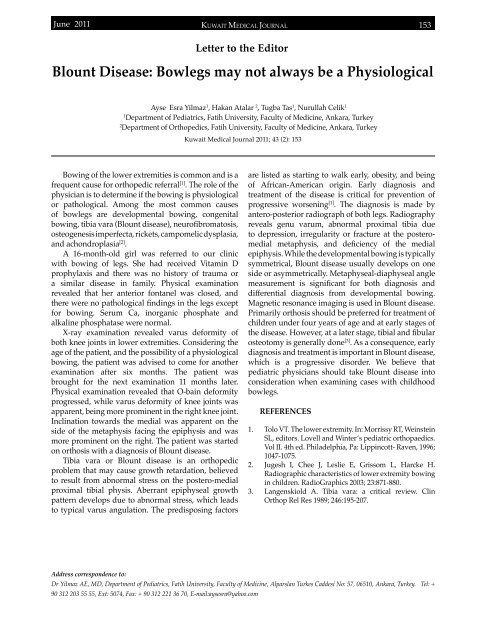Vol 43 # 2 June 2011 - Kma.org.kw
Vol 43 # 2 June 2011 - Kma.org.kw
Vol 43 # 2 June 2011 - Kma.org.kw
Create successful ePaper yourself
Turn your PDF publications into a flip-book with our unique Google optimized e-Paper software.
<strong>June</strong> <strong>2011</strong><br />
KUWAIT MEDICAL JOURNAL 153<br />
Letter to the Editor<br />
Blount Disease: Bowlegs may not always be a Physiological<br />
Ayse Esra Yilmaz 1 , Hakan Atalar 2 , Tugba Tas 1 , Nurullah Celik 1<br />
1<br />
Department of Pediatrics, Fatih University, Faculty of Medicine, Ankara, Turkey<br />
2<br />
Department of Orthopedics, Fatih University, Faculty of Medicine, Ankara, Turkey<br />
Kuwait Medical Journal <strong>2011</strong>; <strong>43</strong> (2): 153<br />
Bowing of the lower extremities is common and is a<br />
frequent cause for orthopedic referral [1] . The role of the<br />
physician is to determine if the bowing is physiological<br />
or pathological. Among the most common causes<br />
of bowlegs are developmental bowing, congenital<br />
bowing, tibia vara (Blount disease), neurofibromatosis,<br />
osteogenesis imperfecta, rickets, campomelic dysplasia,<br />
and achondroplasia [2] .<br />
A 16-month-old girl was referred to our clinic<br />
with bowing of legs. She had received Vitamin D<br />
prophylaxis and there was no history of trauma or<br />
a similar disease in family. Physical examination<br />
revealed that her anterior fontanel was closed, and<br />
there were no pathological findings in the legs except<br />
for bowing. Serum Ca, in<strong>org</strong>anic phosphate and<br />
alkaline phosphatase were normal.<br />
X-ray examination revealed varus deformity of<br />
both knee joints in lower extremities. Considering the<br />
age of the patient, and the possibility of a physiological<br />
bowing, the patient was advised to come for another<br />
examination after six months. The patient was<br />
brought for the next examination 11 months later.<br />
Physical examination revealed that O-bain deformity<br />
progressed, while varus deformity of knee joints was<br />
apparent, being more prominent in the right knee joint.<br />
Inclination towards the medial was apparent on the<br />
side of the metaphysis facing the epiphysis and was<br />
more prominent on the right. The patient was started<br />
on orthosis with a diagnosis of Blount disease.<br />
Tibia vara or Blount disease is an orthopedic<br />
problem that may cause growth retardation, believed<br />
to result from abnormal stress on the postero-medial<br />
proximal tibial physis. Aberrant epiphyseal growth<br />
pattern develops due to abnormal stress, which leads<br />
to typical varus angulation. The predisposing factors<br />
are listed as starting to walk early, obesity, and being<br />
of African-American origin. Early diagnosis and<br />
treatment of the disease is critical for prevention of<br />
progressive worsening [1] . The diagnosis is made by<br />
antero-posterior radiograph of both legs. Radiography<br />
reveals genu varum, abnormal proximal tibia due<br />
to depression, irregularity or fracture at the posteromedial<br />
metaphysis, and deficiency of the medial<br />
epiphysis. While the developmental bowing is typically<br />
symmetrical, Blount disease usually develops on one<br />
side or asymmetrically. Metaphyseal-diaphyseal angle<br />
measurement is significant for both diagnosis and<br />
differential diagnosis from developmental bowing.<br />
Magnetic resonance imaging is used in Blount disease.<br />
Primarily orthosis should be preferred for treatment of<br />
children under four years of age and at early stages of<br />
the disease. However, at a later stage, tibial and fibular<br />
osteotomy is generally done [3] . As a consequence, early<br />
diagnosis and treatment is important in Blount disease,<br />
which is a progressive disorder. We believe that<br />
pediatric physicians should take Blount disease into<br />
consideration when examining cases with childhood<br />
bowlegs.<br />
REFERENCES<br />
1. Tolo VT. The lower extremity. In: Morrissy RT, Weinstein<br />
SL, editors. Lovell and Winter’s pediatric orthopaedics.<br />
<strong>Vol</strong> II. 4th ed. Philadelphia, Pa: Lippincott- Raven, 1996;<br />
1047-1075.<br />
2. Jugesh I, Chee J, Leslie E, Grissom L, Harcke H.<br />
Radiographic characteristics of lower extremity bowing<br />
in children. RadioGraphics 2003; 23:871-880.<br />
3. Langenskiold A. Tibia vara: a critical review. Clin<br />
Orthop Rel Res 1989; 246:195-207.<br />
Address correspondence to:<br />
Dr Yilmaz AE, MD, Department of Pediatrics, Fatih University, Faculty of Medicine, Alparslan Turkes Caddesi No: 57, 06510, Ankara, Turkey. Tel: +<br />
90 312 203 55 55, Ext: 5074, Fax: + 90 312 221 36 70, E-mail:aysesra@yahoo.com
















